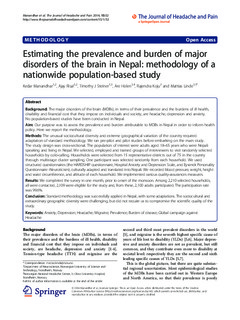| dc.contributor.author | Manandhar, Kedar | |
| dc.contributor.author | Risal, Ajay | |
| dc.contributor.author | Steiner, Timothy J. | |
| dc.contributor.author | Holen, Are | |
| dc.contributor.author | Koju, Rajendra | |
| dc.contributor.author | Linde, Mattias | |
| dc.date.accessioned | 2019-11-07T07:17:52Z | |
| dc.date.available | 2019-11-07T07:17:52Z | |
| dc.date.created | 2014-11-25T09:07:45Z | |
| dc.date.issued | 2014 | |
| dc.identifier.citation | The Journal of Headache and Pain. 2014, 15:52 . | nb_NO |
| dc.identifier.issn | 1129-2369 | |
| dc.identifier.uri | http://hdl.handle.net/11250/2627059 | |
| dc.description.abstract | Background
The major disorders of the brain (MDBs), in terms of their prevalence and the burdens of ill health, disability and financial cost that they impose on individuals and society, are headache, depression and anxiety. No population-based studies have been conducted in Nepal.
Aim
Our purpose was to assess the prevalence and burden attributable to MDBs in Nepal in order to inform health policy. Here we report the methodology.
Methods
The unusual sociocultural diversity and extreme geographical variation of the country required adaptation of standard methodology. We ran pre-pilot and pilot studies before embarking on the main study. The study design was cross-sectional. The population of interest were adults aged 18–65 years who were Nepali speaking and living in Nepal. We selected, employed and trained groups of interviewers to visit randomly selected households by cold-calling. Households were selected from 15 representative districts out of 75 in the country through multistage cluster sampling. One participant was selected randomly from each household. We used structured questionnaires (the HARDSHIP questionnaire, Hospital Anxiety and Depression Scale, and Eysenck Personality Questionnaire -Neuroticism), culturally adapted and translated into Nepali. We recorded blood pressure, weight, height and waist circumference, and altitude of each household. We implemented various quality-assurances measures.
Results
We completed the survey in one month, prior to onset of the monsoon. Among 2,210 selected households, all were contacted, 2,109 were eligible for the study and, from these, 2,100 adults participated. The participation rate was 99.6%.
Conclusion
Standard methodology was successfully applied in Nepal, with some adaptations. The sociocultural and extraordinary geographic diversity were challenging, but did not require us to compromise the scientific quality of the study. | nb_NO |
| dc.language.iso | eng | nb_NO |
| dc.publisher | BioMed Central | nb_NO |
| dc.rights | Navngivelse 4.0 Internasjonal | * |
| dc.rights.uri | http://creativecommons.org/licenses/by/4.0/deed.no | * |
| dc.title | Estimating the prevalence and burden of major disorders of the brain in Nepal: methodology of a nationwide population-based study | nb_NO |
| dc.type | Journal article | nb_NO |
| dc.type | Peer reviewed | nb_NO |
| dc.description.version | publishedVersion | nb_NO |
| dc.source.pagenumber | 8 | nb_NO |
| dc.source.volume | 15:52 | nb_NO |
| dc.source.journal | The Journal of Headache and Pain | nb_NO |
| dc.identifier.doi | 10.1186/1129-2377-15-52 | |
| dc.identifier.cristin | 1176479 | |
| dc.description.localcode | © 2014 Manandhar et al.; licensee Springer. This is an Open Access article distributed under the terms of the Creative Commons Attribution License (http://creativecommons.org/licenses/by/4.0), which permits unrestricted use, distribution, and reproduction in any medium, provided the original work is properly credited. | nb_NO |
| cristin.unitcode | 194,65,30,0 | |
| cristin.unitcode | 1920,28,0,0 | |
| cristin.unitcode | 194,65,35,0 | |
| cristin.unitcode | 1920,16,0,0 | |
| cristin.unitname | Institutt for nevromedisin og bevegelsesvitenskap | |
| cristin.unitname | Klinikk for anestesi og intensivmedisin | |
| cristin.unitname | Institutt for psykisk helse | |
| cristin.unitname | Nevroklinikken | |
| cristin.ispublished | true | |
| cristin.fulltext | original | |
| cristin.qualitycode | 1 | |

